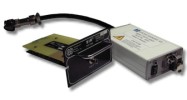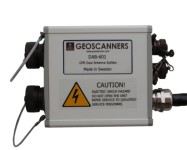Адаптеры
Overview
PRFPLUS-600
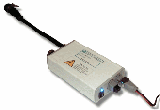
Устройство для поддержки высоко мощных передатчиков PRFPLUS-600 делает возможным использование высоко мощных передатчиков модели 778 производства GSSI или наш VHT501 в режиме высоких ЧПЗИ. Данное устройство также позволяет достичь хороших результатов при использование «высоко мощных» радаров SIR-2 или SIR-2000.
[ещё...]
DAB-601

Антенна сплитер DAB-601 делает возможным использование двух антенн в би-статическом режиме с георадарами имеющими только один канал. Одним из преимуществ DAB-601 является способность автоматического выбора отправления импульсов запуска приемника/передатчика по одному и тому же каналу или раздельно в зависимости от количества подключенных антенн. Кроме того использование данного устройства делает возможным использование одометра или кнопки маркера с антеннами у которых нет специальных выходов для них.
[ещё...]
LLD702
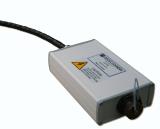
Newer ground penetrating radar systems from GSSI have been optimized for low power consumption and sharp triggering edges, but, as always, there is a price to pay for good things. These radar systems are incapable of driving cable lengths exceeding 30 meters or 10 feet. For borehole antennas going into the ground several tens of meters that can be a huge problem. The LLD702 long line driver deals with those issues in the best effective and hassle free way.
Read more >>
DAB-602
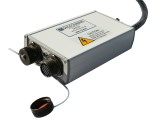
Using two antennas with single channel ground penetrating radars can be achieved using the DAB-601. The DAB-601 however, won't let you choose where the transmitter and where the receiver are. In some ocasions it is necessary to be able to swap back and forth the role of the antennas in the bistatic configuration. This has to be done without deataching the antennas and this is when the DAB-602 comes handy, since that is exactly what it does.
Read more >>
Overview
PRFPLUS-600
Save Time, See More and Don't Loose Valuable Data!
Anyone who has tried to connect the very high power transmitter 778 from GSSI to the SIR-3000 knows what a complaining beep of the radar system sounds like. Those who are lucky get away just by unplugging the unit and taking a deep breath while connecting back the short coax on the transceiver unit. Those of us who were not lucky enough ended up reinstalling the software in the radar unit. And all that trouble because in the reality the SIR-3000, while an excellent unit; was not designed to handle that kind of power.
The transceiver model 769DA2 from GSSI is an excellent piece of hardware only super exceeded by our TR501, but in either case one would like to have a little more penetration. Then is when you get to the phone and order a more powerful unit to do the job. After having all set there it comes; the beep you don’t want to hear. What to do?
The solution is finally here and is called the PRFPLUS-600! (say pee-ar-eff-plus six hundred)
It is: safe, easy to operate, slim, not power hungry, RoHS compliant, EMC compliant and well, it looks nice too.
[Brochure]
The PRFPLUS-600 will not only allow for faster surveys but will also protect the high voltage circuitry of your expensive radar system. The PRFPLUS-600 was designed in such a way that it isolates (DC, of course) completely the radar unit from the plug in electronics, providing a barrier and a protection with it. If something goes wrong with your plug in electronics you'll know about it in good time. The power for the plug in electronics is suspended immediately after a fault condition has been detected and there's a second chance for your equipment.
[User Manual]
Anyone who has tried to connect the very high power transmitter 778 from GSSI to the SIR-3000 knows what a complaining beep of the radar system sounds like. Those who are lucky get away just by unplugging the unit and taking a deep breath while connecting back the short coax on the transceiver unit. Those of us who were not lucky enough ended up reinstalling the software in the radar unit. And all that trouble because in the reality the SIR-3000, while an excellent unit; was not designed to handle that kind of power.
The transceiver model 769DA2 from GSSI is an excellent piece of hardware only super exceeded by our TR501, but in either case one would like to have a little more penetration. Then is when you get to the phone and order a more powerful unit to do the job. After having all set there it comes; the beep you don’t want to hear. What to do?
The solution is finally here and is called the PRFPLUS-600! (say pee-ar-eff-plus six hundred)
It is: safe, easy to operate, slim, not power hungry, RoHS compliant, EMC compliant and well, it looks nice too.
[Brochure]
The PRFPLUS-600 will not only allow for faster surveys but will also protect the high voltage circuitry of your expensive radar system. The PRFPLUS-600 was designed in such a way that it isolates (DC, of course) completely the radar unit from the plug in electronics, providing a barrier and a protection with it. If something goes wrong with your plug in electronics you'll know about it in good time. The power for the plug in electronics is suspended immediately after a fault condition has been detected and there's a second chance for your equipment.
[User Manual]
Overview
DAB-601
Bistatic or Monostatic?
In Ground Penetrating Radar the terms "Monostatic" and "Bistatic" are use quite freely. Many times when experts talk about antennas operating in monostatic mode, in the reality they mean bistatic mode but with the transmit and receive channels very close to one another. However, strictly speaking in monostatic operation a common antenna is used for both transmitting and receiving. While in bistatic operation, the transmitting and receiving antennas are different and might be placed at a considerable distance from one another. Any antenna that accepts plug-ins like the TR501 transceiver or in the lack of it a 769DA2 transceiver, can be operated in monostatic mode.
Is it any use of operating the antennas in bistatic mode?
What can be done in bistatic mode that cannot be done in monostatic mode? Common Mid Point (CMP) measurements, Wide-Angle Reflection and Refraction (WARR) test and Transilumination measurements are possible only in bistatic mode. All of which are direct wave measurements and they provide information about electromagnetic wave velocity in the media and sometimes are used for creating 3D radargram structures. It is possible to use two identical antennas with a two channel radar for performing measurements in bistatic mode. On the other hand if you have a single channel radar like the SIR-3000, then bistatic mode is not possible unless you have an antenna channel splitter like our DAB-601.
The DAB-601 Advantages over existing solutions
The DAB-601 has many advantages over all the existing solutions for GSSI compatible radar systems:
Both Monostatic and Bistatic modes of operation are supported
Full automatic switching, no coaxes involved
Marker button input connector present on the unit
Survey Wheel connector with output/input compatible with GSSI specs.
0.1dB Insertion Loss for triggers up to 3GHz.
On top of that the DAB-601 is safe, easy to operate, RoHS compliant and EMC compliant. [Brochure]
You can find out more about the DAB-601 in the users manual.
[User Manual]
In Ground Penetrating Radar the terms "Monostatic" and "Bistatic" are use quite freely. Many times when experts talk about antennas operating in monostatic mode, in the reality they mean bistatic mode but with the transmit and receive channels very close to one another. However, strictly speaking in monostatic operation a common antenna is used for both transmitting and receiving. While in bistatic operation, the transmitting and receiving antennas are different and might be placed at a considerable distance from one another. Any antenna that accepts plug-ins like the TR501 transceiver or in the lack of it a 769DA2 transceiver, can be operated in monostatic mode.
Is it any use of operating the antennas in bistatic mode?
What can be done in bistatic mode that cannot be done in monostatic mode? Common Mid Point (CMP) measurements, Wide-Angle Reflection and Refraction (WARR) test and Transilumination measurements are possible only in bistatic mode. All of which are direct wave measurements and they provide information about electromagnetic wave velocity in the media and sometimes are used for creating 3D radargram structures. It is possible to use two identical antennas with a two channel radar for performing measurements in bistatic mode. On the other hand if you have a single channel radar like the SIR-3000, then bistatic mode is not possible unless you have an antenna channel splitter like our DAB-601.
The DAB-601 Advantages over existing solutions
The DAB-601 has many advantages over all the existing solutions for GSSI compatible radar systems:
Both Monostatic and Bistatic modes of operation are supported
Full automatic switching, no coaxes involved
Marker button input connector present on the unit
Survey Wheel connector with output/input compatible with GSSI specs.
0.1dB Insertion Loss for triggers up to 3GHz.
On top of that the DAB-601 is safe, easy to operate, RoHS compliant and EMC compliant. [Brochure]
You can find out more about the DAB-601 in the users manual.
[User Manual]
Overview
LLD702
When thirty meters cable is not enough
The need for longer cables to drive the ground penetrating radar antennas can arise at any moment, usually when least expected. In the case of newer GSSI radar systems buying a new longer cable might help or might not, everything depends on the length of the new cable. GSSI states a maximum of 30 meters (98.4 feet) cable for their top of the line radars the SIR3000 and the SIR20. We have found out that in the reality a little bit more than that is achievable, although the data does indeed starts to deteriorate short after that.
In this particular situation there are a couple of options available to the gpr practitioner: to buy a long line driver from GSSI or to buy the long line driver LLD702 from us. For us the choice is obvious, but of course you might say that the reason is obvious as well. Let's take a closer look at what we have to offer and why we believe ours is better.
How the LLD702 is better than similar units in the market?
The main three reasons to buy our LLD702 are:
It does not need any extra short cable: our unit connects directly to the ground penetrating radar unit and presents an output to the control cable identical to the one the radar usually presents. This is very important because extra cables translate rapidly into extra cash spended for the same purpose.
It has faster triggering pulses: the output triggers from the LLD702 are 0.7ns faster than similar units giving a lower jitter and consequently a lest time distortion on the acquired b-scans.
It has a LF amplifier: the LLD702 has an internal broadband amplifier for the data line to compensate for all the loses in the long cable. Extra software gain won't be necessary in this case.
The LLD702 is ideal to drive borehole antennas
If one of your main applications is borehole antenna surveys then the LLD702 is something you are going to need sooner or later when operating them with the SIR3000 or SIR20 from GSSI. Is our experience that the SIR20 can run longer cables than the SIR3000, but even then the benefits of using the LLD702 are many.
You can find out more about the LLD702 in the users manual.
[User Manual]
The need for longer cables to drive the ground penetrating radar antennas can arise at any moment, usually when least expected. In the case of newer GSSI radar systems buying a new longer cable might help or might not, everything depends on the length of the new cable. GSSI states a maximum of 30 meters (98.4 feet) cable for their top of the line radars the SIR3000 and the SIR20. We have found out that in the reality a little bit more than that is achievable, although the data does indeed starts to deteriorate short after that.
In this particular situation there are a couple of options available to the gpr practitioner: to buy a long line driver from GSSI or to buy the long line driver LLD702 from us. For us the choice is obvious, but of course you might say that the reason is obvious as well. Let's take a closer look at what we have to offer and why we believe ours is better.
How the LLD702 is better than similar units in the market?
The main three reasons to buy our LLD702 are:
It does not need any extra short cable: our unit connects directly to the ground penetrating radar unit and presents an output to the control cable identical to the one the radar usually presents. This is very important because extra cables translate rapidly into extra cash spended for the same purpose.
It has faster triggering pulses: the output triggers from the LLD702 are 0.7ns faster than similar units giving a lower jitter and consequently a lest time distortion on the acquired b-scans.
It has a LF amplifier: the LLD702 has an internal broadband amplifier for the data line to compensate for all the loses in the long cable. Extra software gain won't be necessary in this case.
The LLD702 is ideal to drive borehole antennas
If one of your main applications is borehole antenna surveys then the LLD702 is something you are going to need sooner or later when operating them with the SIR3000 or SIR20 from GSSI. Is our experience that the SIR20 can run longer cables than the SIR3000, but even then the benefits of using the LLD702 are many.
You can find out more about the LLD702 in the users manual.
[User Manual]
Overview
DAB-602
Bistatic or Monostatic?
In Ground Penetrating Radar the terms "Monostatic" and "Bistatic" are use quite freely. Many times when experts talk about antennas operating in monostatic mode, in the reality they mean bistatic mode but with the transmit and receive channels very close to one another.
However, strictly speaking in monostatic operation a common antenna is used for both transmitting and receiving. While in bistatic operation, the transmitting and receiving antennas are different and might be placed at a considerable distance from one another. Any antenna that accepts plug-ins like the TR501 transceiver or in the lack of it a 769DA2 transceiver, can be operated in monostatic mode.
Is it any use of operating the antennas in bistatic mode?
What can be done in bistatic mode that cannot be done in monostatic mode? Common Mid Point (CMP) measurements, Wide-Angle Reflection and Refraction (WARR) test and Transilumination measurements are possible only in bistatic mode. All of which are direct wave measurements and they provide information about electromagnetic wave velocity in the media and sometimes are used for creating 3D radargram structures.
It is possible to use two identical antennas with a two channel radar for performing measurements in bistatic mode. On the other hand if you have a single channel radar like the SIR-3000, then bistatic mode is not possible unless you have an antenna channel splitter like our DAB-601 or DAB-602
DAB-601 or DAB-602? That's the question.
The DAB-602 should be used instead of the DAB-601 when:
You need to switch or "swap" the transmitter and receiver on the antennas, or
You need to select monostatic or bistatic mode without deataching antennas
Don't need an input for the marker button since it is used for the toggling control
Don't need automatic control.
The DAB-602 as the DAB-601 is safe, easy to operate, RoHS compliant and EMC compliant.
You can find out more about the DAB-602 in the users manual. [User Manual]
In Ground Penetrating Radar the terms "Monostatic" and "Bistatic" are use quite freely. Many times when experts talk about antennas operating in monostatic mode, in the reality they mean bistatic mode but with the transmit and receive channels very close to one another.
However, strictly speaking in monostatic operation a common antenna is used for both transmitting and receiving. While in bistatic operation, the transmitting and receiving antennas are different and might be placed at a considerable distance from one another. Any antenna that accepts plug-ins like the TR501 transceiver or in the lack of it a 769DA2 transceiver, can be operated in monostatic mode.
Is it any use of operating the antennas in bistatic mode?
What can be done in bistatic mode that cannot be done in monostatic mode? Common Mid Point (CMP) measurements, Wide-Angle Reflection and Refraction (WARR) test and Transilumination measurements are possible only in bistatic mode. All of which are direct wave measurements and they provide information about electromagnetic wave velocity in the media and sometimes are used for creating 3D radargram structures.
It is possible to use two identical antennas with a two channel radar for performing measurements in bistatic mode. On the other hand if you have a single channel radar like the SIR-3000, then bistatic mode is not possible unless you have an antenna channel splitter like our DAB-601 or DAB-602
DAB-601 or DAB-602? That's the question.
The DAB-602 should be used instead of the DAB-601 when:
You need to switch or "swap" the transmitter and receiver on the antennas, or
You need to select monostatic or bistatic mode without deataching antennas
Don't need an input for the marker button since it is used for the toggling control
Don't need automatic control.
The DAB-602 as the DAB-601 is safe, easy to operate, RoHS compliant and EMC compliant.
You can find out more about the DAB-602 in the users manual. [User Manual]
Overview
If you don't receive an answer from us within 15 to 20 minutes please fill up the PDF form, save it to your hard driver and send it to as an attachment.


 Svenska
Svenska Español
Español English
English

